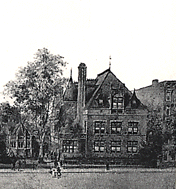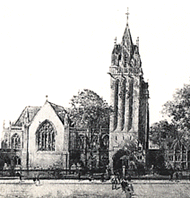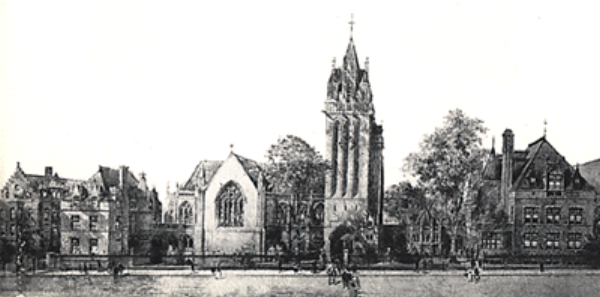History of the parish
"Go ye, therefore, and teach all nations, baptizing them in the name of the Father, and of the Son, and of the Holy Ghost." Matthew 28:19
Inscription on the Portal of the Church of the Holy Trinity
More than 100 years ago, The Church of the Holy Trinity was established through the confluence of three events—Serena Rhinelander’s desire to create a memorial to her father and grandfather, the merger of the original Church of the Holy Trinity with St. James Church and the needs of St. James Mission on East 83rd Street.

Serena Rhinelander’s grandfather, William Rhinelander (one of the wealthiest men in New York) in 1798 purchased 72 acres stretching from Third Avenue to the East River for a summer home. The northward growth of the city led to the Rhinelanders’ selling much of that land. However, Serena Rhinelander wanted as a memorial to her father and grandfather to donate not only the midblock site on the south side of 88th Street between Second and First Avenues, but also the cost of designing and constructing a church complex.
Serena Rhinelander wanted to make this donation to St. James Church at 71st Street and Madison Avenue and have St. James become the sponsor of the new complex in what had become a working-class neighborhood. However, St. James Church could not accept her offer because they did not have the money to maintain the church.

The maintenance money came from the original Church of the Holy Trinity (see photo). The church, located on the northeast corner of Madison Avenue and 42nd Street, wished to move from the business district and decided to sell its property and unite with St. James Church.
The Diocese of New York arranged to transfer Holy Trinity’s assets from the sale of the property to St. James. This, in turn, enabled St. James to retire its own debt and to assume sponsorship for Serena Rhinelander’s memorial by establishing a $200,000 endowment fund. The Diocese also transferred the name of the church to the proposed new complex. Thus the generosity of Serena Rhinelander and the endowment from St. James enabled an institution the neighborhood could not have afforded.
At the same time, St. James also had a mission at 419 East 83rd Street that had outgrown its space. This mission was moved in 1897 to the first building completed on the site, St. Christopher's House, and administered by the mission's trustees.

St. Christopher's House was a clubhouse and kindergarten for all the children of the neighborhood no matter what their individual faith or if they had no faith at all. In the basement was a swimming pool which could be used for a nominal fee and on the top floor a well-equipped gymnasium. There were a circulating library, assembly rooms, playrooms and public showers.
On April 28, 1897 the new congregation began to worship in the assembly room of St. Christopher's House.
Construction of the new Church of the Holy Trinity began the following November with the laying of the cornerstone for the church. The New York Times described the ceremony:
"...white vestments of the clergymen and the representatives of the highest social and intellectual circles on the one side showed in vivid contrast to the row of tenements across the street, from every window and door of which gazed a curious throng of people, for whose use the edifice was being dedicated."

On May 6, 1899 the Church of the Holy Trinity was consecrated. The following are excerpts from the sermon by Rev. Dr. William R. Huntington of Grace Church:
"It may shock some to hear it, but consecration is not the mere act of the Bishop; it is a process that requires time to develop, and only years of use can properly consecrate a building like this…A church should not only be pleasing to the eye, but should be adapted to all the uses of a church. I can define them in three words—instruction, devotion and mercy. The pulpit, the altar and works of mercy form a part of the proper work of the church, and this group of buildings is fitted for all..."
Holy Trinity was built to be a "settlement church" which aimed to "cultivate the best in man, physical, mental, social and spiritual ... not content to preach only to the soul ... but with its clubs and societies seeks to help and elevate the social conditions amongst its members and the neighborhood in which it stands."
From 1897 to 1919 James V. Chalmers was the Vicar of Holy Trinity, and the early parish newsletters, The Chimes, describe a large and active Christian community. At that time the programs included a coal cooperative, day nursery for children of working parents, sewing clubs, and Christian education including a Sunday School of over 1,000 children. There were also excursions, lectures, and amateur theatricals. Holy Trinity remained a chapel of St. James until 1951, when, under the leadership of Rev. James Paul, it became an independent parish.
In 1897 the intention of the "settlement church" was to minister to the physical and spiritual needs of the growing immigrant community surrounding it. Although we no longer call Holy Trinity a "settlement church", its mission has not changed. It is still a landmark of architectural and social significance with its strong ministry to the people of Yorkville and East Harlem.
